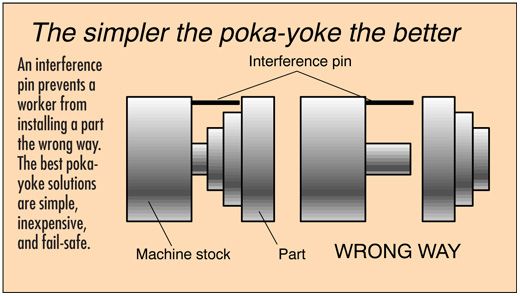Imagine the power of preventing a mistake before it even happens. That’s Poka Yoke. Poka Yoke is any mechanism in a Lean manufacturing process that helps to avoid mistakes.
Although it sounds like an anime character or a board game, in Lean Six Sigma, Poka Yoke is one of the most powerful work standardization techniques that can be applied to any manufacturing or service industry.
 Poka Yoke ensures that the right conditions exist before a process step is executed, and this prevents defects, mistakes, or accidents from occurring in the first place. Where this isn’t possible, Poka Yoke performs a detective function, eliminating defects in the process as early as possible.
Poka Yoke ensures that the right conditions exist before a process step is executed, and this prevents defects, mistakes, or accidents from occurring in the first place. Where this isn’t possible, Poka Yoke performs a detective function, eliminating defects in the process as early as possible.
Its purpose is to eliminate product defects by preventing, correcting, or drawing attention to human errors as they occur. In a broader sense, it’s also a behavior-shaping constraint as a process step to prevent incorrect operation.
You’re already surrounded by Poka Yokes and don’t know it.
Many examples of Poka Yoke are so mundane that we often don’t realize they are there. Error-proofing in everyday life ranges from safety features that prevent us from getting injured to spell check—which simply prevents us from making spelling errors that make us look dumb.
Car safety features: Cars are equipped with many “error-proofing” features to keep us safe on the road. Many cars will beep, or light up, if doors are open while the engine is running, or if someone is in the passenger seat and their seatbelt is not fastened. These are examples of warning functions, which alert users to potential errors.
Treadmills: Treadmills are required to come equipped with a safety clip which, when pulled, stops the treadmill. This safety feature halts the treadmill if the user falls (assuming that the user is wearing the clip) in order to prevent injury.
Microwaves, washing machines, dishwashers, and other household appliances: Many household appliances such as microwaves, washing machines and dryers, and dishwashers have mechanisms that prevent them from running when the door is open. These are examples of control functions, which prevent the process from running until required conditions (i.e. the door being closed) have been met.
Elevators and garage doors: Most elevators are equipped with sensors that prevent the doors from closing if there is something or somebody in the way. Garage doors, subway doors, and other automatic doors are also equipped with this feature. Many elevators also beep and refuse to run if they exceed the weight limit.
Poka Yoke’s origin story.
The term Poka Yoke was coined in Japan during the 1960s by Shigeo Shingo. Originally, the initial term was baka-yoke, meaning ‘fool-proofing’, but was later changed because of the term’s dishonorable and offensive connotation—respect for others being a foundational principle for Lean Six Sigma.
Poka Yoke means ‘mistake-proofing’ or more literally – avoiding (yokeru) inadvertent errors (poka).
Why is Poka Yoke important?
The value of using Poka Yokes is that they help people and processes work right the first time, which makes mistakes impossible to happen. These techniques can significantly improve quality and reliability of products and processes by eliminating defects.
 Applying simple Poka Yoke ideas and methods in product and process design can eliminate both human and mechanical errors.
Applying simple Poka Yoke ideas and methods in product and process design can eliminate both human and mechanical errors.
Examples of Poka Yoke in manufacturing or factory work.
- Magnets in a grain packaging plant detect and remove metal pieces before they are packed.
- Interlock switches which detect the position of a machine guard and switch off the machine when the guard is lifted. The machine will never operate when the guard has been lifted and this prevents accidents to the operator.
- Light curtains in a factory detect when someone is near very dangerous machines and switches off the machine to prevent injuries.
- Safety mats near machine areas that pose a danger automatically trigger stoppage when someone steps on them. This prevents injury to personnel (such are technicians) who are trying to access dangerous sections of a machine.
- Power guards on high inertia machines with moving parts prevent opening until the parts have stopped completely in order to prevent accidents.
- Machines that must be controlled using both hands ensure that some distance is kept between the operator and dangerous machine parts.
- In the food industry, gloves and other small pieces of personal protective equipment must be blue in color for ease of detection in case they fall into food. This is because blue foods are rare in nature, and the color difference makes it easy to detect that a foreign object has fallen into the food.
- Using standardized containers at the workstation enables workers to know exact quantities without having to weigh or count the contents.
- Use of color-coded date labels to mark the production dates of products. This way the different batches are easily identifiable for the purpose of product rotation. The system is especially useful in the food industry where rotation of batches is very important because of hygiene considerations.
When and how to use Poka Yoke.
The Poka Yoke technique could be used whenever a mistake could occur or something could be done wrong – meaning everywhere. It can be successfully applied to any type of process in manufacturing or services industry, preventing all kinds of errors.
Poka yoke is easy to implement because of its universal and rational nature. You can follow this step by step process to apply it:
- Identify the operation or process.
- Analyze the 5-whys and the ways a process can fail.
- Choose the right Poka Yoke approach, such as using a shutout type(preventing an error being made), or an attention type (highlighting that an error has been made).
- Take a comprehensive approach instead of thinking of Poka Yokes just as limit switches, or automatic shutoff.
- Determine whether a contact(use of shape, size, or other physical attributes for detection), constant number (error triggered if a certain number of actions are not made), or a sequencing method (use of a checklist to ensure completing all process steps) is most appropriate.
- Test the method and see if it works.
- Train the operator, review performance, and measure success.
In summary
Poka Yoke technique is a way of ensuring quality without actually having a quality assurance process, rather preventing defects to appear in the first place.



